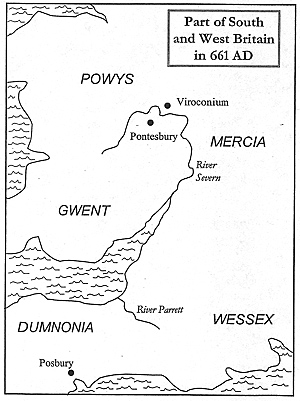Introduction
In an attempt to convince readers that it really isn't that hard to research and wargame local battles, here are some notes on what I did for one such engagement. I have tried to illustrate the sort of process by which an historical footnote can become a hopefully interesting and slightly different wargame. It is not intended as a definite account of the battle. You won't find detailed deployments or orders of battle. I doubt sufficient evidence exists for prepare such an account, certainly not in a form that is accessible to a non-expert like me.
 Background
Background
I first became aware of this battle while reading a general book on the Shropshire Hills. Describing Pontesford Hill it contained a promising section starting "........ the battle fought here in the seventh century ......."[1].
A quick check in a translation of the Anglo Saxon Chronicles revealed the promising entry for 661 AD "Cenwalh fought at Easter at Posentbyrig, and Wulfhere, son of Penda ravaged up to Ashdown"[2]. This is almost a standard formula. For example, a few lines earlier is the entry for 658, "Cenwalh fought at Penselwood with the Welsh, and they put them to flight to the Parrett". The 661 entry suggests Cenwalh lost a battle against Wulfhere, although the entry could relate to two entirely separate incidents.
A standard work [3] disclosed that Cenwalh was the King of Wessex and Wulfhere was the King of Mercia. At this time Mercia was one of two major powers in Britain, the other was Northumbria. Needless to say these two were constantly at odds. In 661 Mercia had just re-established independence from Northumbria previously lost at the death of Penda in 655. Wessex was a growing power, but was not in the same league as Mercia or Northumbria, and was also in constant conflict with Mercia.
A quick trip to the library turned up the following additional background information [4].
Pontesbury is a small Shropshire town lying about 8 miles south west of Shrewsbury. It lies alongside the Rea Brook, an important route into mid Wales since at least Roman times. It was already a significant settlement by the time of Domesday although its exact origins are unknown. The present town is overlooked by at least two major hillforts. These have been attributed to the period of the battle itself, but there is nothing about the sites to suggest they are other than Iron Age hillforts. These may have been reused in the post Roman period like other such sites (e.g. South Cadbury in Somerset) although I found no reference to definite evidence for this at Pontesbury.
For the first part of the seventh century much of what is now Shropshire was part of the Kingdom of Powys. This post Roman state extended much beyond the current area of Wales that has the same name, and may have been ruled from the old Roman City of Viroconium (Wroxeter). Current evidence suggests the centre of Viroconium was peacefully abandoned in the early seventh century and buildings dismantled for use elsewhere. Powys had been a long time ally to Mercia. The people of this part of Powys became known as the "Wreocensaetan", a Mercian sub-tribe, some time between about 640 and 670. The transition was quite possibly voluntary.
Local legend offers a few more tantalising strands. By tradition the villagers of Pontesbury raced up Pontesford Hill on Palm Sunday (another Easter connection !) to find a golden arrow lost by a King/Prince/Fairy in a battle. There are restrictions as to who may succeed. The favourite eligible candidates are a twenty one year old maiden, or the seventh daughter of a seventh son. Success will result in the lifting of an unspecified curse, or restore the long lost rightful heir to a local unnamed estate. Other variations of this race include collecting a frond from the ancient magic yew tree on the hill and being the first to take it to the bottomless spring at the foot of the hill or is it to the village church? The result may be the same as finding the arrow, or as mundane as discovering the name of your true love.
The novel "The Golden Arrow" by Mary Webb borrows heavily on these stories as background. I must confess I found this very heavy going and have never reached beyond the first few dozen pages.
The only other element left to consider from the Chronicle entry is the location of Ashdown, which seems to be the limit of Wulfheres pursuit. Unfortunately no likely candidates have been identified in the West Midlands or Welsh Marches.
That is about as far as real history or genuine local traditions can take us. How can this be knitted together to make a plausible campaign, using as many as possible of the snippets above? Of course, given the lack of anything concrete there are many possibilities. Here is a scenario I came up with, one that tries to incorporate just about everything without straining history too much.
More Pontesbury 661AD
Back to Table of Contents -- Lone Warrior #139
Back to Lone Warrior List of Issues
Back to MagWeb Magazine List
© Copyright 2002 by Solo Wargamers Association.
This article appears in MagWeb (Magazine Web) on the Internet World Wide Web.
Other military history articles and gaming articles are available at http://www.magweb.com
